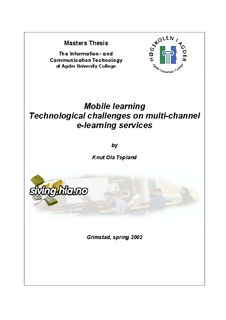| dc.contributor.author | Topland, Knut Ola | |
| dc.date.accessioned | 2007-07-10T14:14:43Z | |
| dc.date.issued | 2002 | |
| dc.identifier.uri | http://hdl.handle.net/11250/137296 | |
| dc.description | Masteroppgave i informasjons- og kommunikasjonsteknologi 2002 - Høgskolen i Agder, Grimstad | en |
| dc.description.abstract | The focus of this thesis is the challenge of developing multi-channel e-learning services on
Internet in which the content is located at the same node. Multi-channel is here defined as the
technology which is using a framework on how the content should be distributed such as web,
wap, phone and fax. The term multi-channel e-learning service means an electronic learning
service which is capable to provide the same content to a number of different devices using
more than one media type such as text, sound, picture, video and data sent in both directions.
The thesis concentrates on the technological architectures, the current official standards,
mobile end-user devices, and how this technology can improve the learning processes.
Chapter one gives some basis and definitions in the range of the subject. Second chapter
describes relevant e-learning theory. A describing and discussing of the multi-channel
approach is in chapter three. Chapter four defines and discusses technological architectures
and standards. A prototype which is based on central parts of the learning theory and
technology architecture is presented in chapter five. In the final chapter a discussion is done.
Result from this thesis work shows that it might be reasonable to assume that multi-channel elearning
services can be developed by using current technological standards. By using the
control content standards that negotiate device capabilities to the content server there is
reasonable to conclude that methods can be made to control the quality of the distributed
content. Hence, prototype tests have shown that older devices or browsers does not support
content control standards which can give problems to realize multi-channel services that uses
these content control methods. Content control can also help content editors to improve the
learning outcome and utilize the service to increase the user’s learning process. | en |
| dc.format.extent | 592197 bytes | |
| dc.format.mimetype | application/pdf | |
| dc.language.iso | eng | en |
| dc.publisher | Høgskolen i Agder | |
| dc.publisher | Agder University College | |
| dc.subject.classification | IKT590 | |
| dc.title | Mobile learning : technological challenges on multi-channel e-learning services | en |
| dc.type | Master thesis | en |
| dc.subject.nsi | VDP::Matematikk og naturvitenskap: 400::Informasjons- og kommunikasjonsvitenskap: 420::Kunnskapsbaserte systemer: 425 | |
| dc.subject.nsi | VDP::Matematikk og naturvitenskap: 400::Informasjons- og kommunikasjonsvitenskap: 420::Systemutvikling og -arbeid: 426 | |
